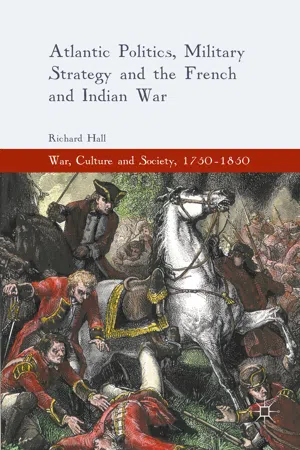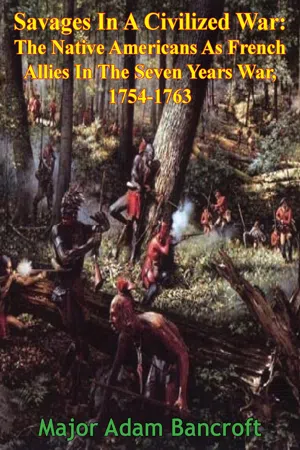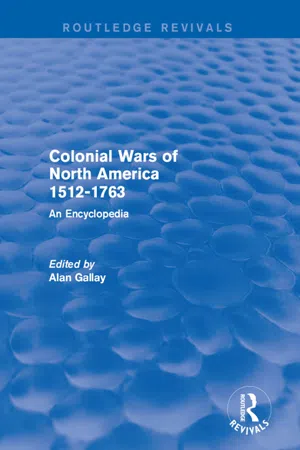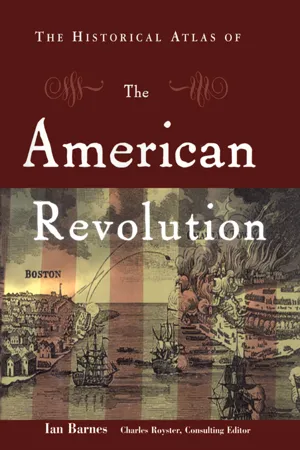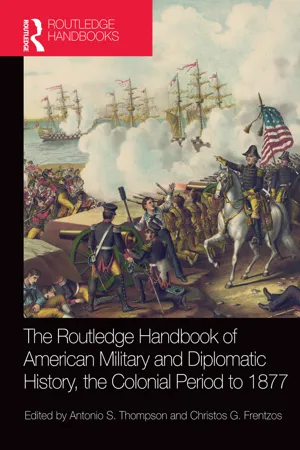History
French and Indian War
The French and Indian War was a conflict between the British and French, with both sides enlisting Native American allies, fought in North America from 1754 to 1763. It was part of the larger Seven Years' War and resulted in the British gaining control of Canada and Florida from the French, but also contributed to tensions that eventually led to the American Revolutionary War.
Written by Perlego with AI-assistance
Related key terms
9 Key excerpts on "French and Indian War"
- Richard Hall(Author)
- 2016(Publication Date)
- Palgrave Macmillan(Publisher)
Alas, as time progresses and as new historic epochs are written, it is probable that this great war for imperial preeminence will fade yet further into the distance of national memory. Nevertheless, the French and Indian War and the wider Seven Years War it spawned are decisive conflicts in global history. The latter was a conflagration that would be fought on all of the world’s major continents; from Europe to Asia, the Americas and Africa. Its immediate legacies included the bankrupting of nations, the wanton sacrifice of countless lives and the devastation of whole communities. In Europe, the Seven Years War led to the emergence of Russia and Prussia as great continental powers, while in North America, the French and Indian War was instrumental in laying the political foundations of the American Revolution; which in turn led to the birth of the United States of America. What was an undoubtedly global war should, therefore, be proclaimed the true First World War and, indeed, this is how many historians now view this momentous event. That such a transformative conflict began in the sparsely settled and unfamiliar terrain of the Ohio Valley, a region in the then backwoods of North America, is testimony to that continent’s increasing strategic importance to the courts and governments of eighteenth-century Europe. 3 From being a region completely devoid of any major European influence prior to 1492, North America, settled by the French, British (and Dutch) in the early seventeenth century, became a theater that by 1754, the eve of conflict, played a pivotal role in the great dynastic game that was European diplomacy in the eighteenth century- eBook - ePub
- Armstrong Starkey(Author)
- 2002(Publication Date)
- Routledge(Publisher)
During 1763 triumphant British regulars would be chastened by native foes who continued to possess tactical superiority in forest warfare. French-Indian relations The names of the wars discussed in this chapter reflect the imperial dimension of North American conflict. “King William’s War”, “Queen Anne’s War”, “King George’s War” recall these events from an English perspective. So too does “French and Indian War”, the name commonly applied to the North American aspect of the Seven Years War when conflict actually began in 1754. But “French and Indian War” within the Anglo-American historical memory recalls not only the imperial struggle for the possession of a continent, but also a certain kind of war: the war of the frontiers, a war in which the French and their Indian allies excelled and which terrorized the inhabitants of the English border settlements. The ferocity of those raiders still conjures up nightmares, as the present author can testify, having been thoroughly terrified as a boy by the warrior Magua in The Last of the Mohicans. The Indians always seem to have been on their side, placing Americans’ hapless frontier ancestors at a distinct disadvantage. Of course that was not always the case, but it was sufficiently true to have given the French the military initiative until 1758. Indian alliances were the most important military asset possessed by the French Empire in North America. French success in forming such alliances is attributable to many factors, intelligent leadership not being the least. The very nature of French imperialism in North America made France the more desirable partner for many native peoples. It was an empire of commerce rather than settlement, one whose reach, thanks to the exploitation of excellent interior water communications, was extensive but light. French traders brought prized European goods including firearms to distant peoples in Illinois and on the Great Lakes, but did not threaten their autonomy - eBook - ePub
- Major Adam Bancroft(Author)
- 2015(Publication Date)
- Golden Springs Publishing(Publisher)
CHAPTER 2 — CANADIAN-INDIAN RELATIONS AND FRENCH WARTIME STRATEGY FOR NATIVE AMERICAN USE
“What has resulted from this? And what is resulting from this? Our Indians, disgusted, and dissatisfied, are taking their furs to the English, are becoming attached to them to the prejudice of our interests and to the detriment of the trade. . . . The presents that the king has given to them keep them loyal to him.”{8} — Charles de Raymond, On the Eve of ConquestThe Native Americans played an essential role for both the British and French Empires in North America during the Seven Years’ War (1754-1763). They were essential to the survival of the colonists that inhabited the areas. They were vital trading partners; they acted as guides, and in the case of some British agreements, also hunted to provide food for the settlers.{9} The Indians also provided the essential manpower that the French relied upon to help offset the British settlements vast advantage on the continent, 1.5 million settlers to the French 55,000.{10}This employment as soldiers in the army did not develop only in the years leading up to war. Instead, securing the alliances and good relations with the Indians that were needed to develop the constant flow of manpower the war demanded were the result of carefully molded colonial policy and diplomatic relations with their neighboring tribes in the vast areas that were settled by the French. This policy, relying on gifts, flattery, and favors, and not the purchase or outright control of the Indians’ land allowed them to rapidly expand and trade for the furs that were so valued in Europe.{11}This relationship also had a double edge to it. When the style of warfare of the Seven Years’ War moved past the small-scale frontier war of the late 16th and early 17th centuries to a large European style war, the French had trouble adapting their small regular force augmented by Indians to the European style. Conversely, the large European armies had trouble maneuvering in the dense terrain of the Americas. In the middle were the Native Americans. The Canadian Governor General Pierre de Riguad de Vaudreuil de Cavagnial, Marquis de Vaudreuil (known here after as Vaudreuil) advocated a much more defensive forward guerilla style campaign{12} as the French leadership’s best strategy to employ the Native Americans, while the French military commander, Major General Louis-Joseph de Montcalm, Marquis de Montcalm (known here after as Montcalm) sought a more European maneuver army strategy of massing for decisive battles with the Indians as auxiliaries.{13} Their eventual usage, as scouts and guerillas, would be born of the relationship between the Indians and the French as allies and partners and not as subjects or subordinates, a direct result of the relations cultivated between them outside of war.{14} - eBook - ePub
- Jeremy Black(Author)
- 2021(Publication Date)
- Casemate Academic(Publisher)
This ensured that the war for empire was to the fore earlier in the Seven Years’ War, although the commitment to Germany was also to be conceptualised in terms of winning America in Germany, by means of the distraction of French forces. At the same time, the subsequent reading back of strategic assessment in order to vindicate or castigate policy choices requires correction in terms of the particular issues, problems and discussions of the time. This is notably so of the ‘slowing down’ of past analysis arising from the need to address specific conundrums in terms of the prioritisation of resources in a context of limited information and uncertain performance. This situation was accentuated by the geographical scale of commitments, and the consequent timescale of deployment.Fighting had broken out in the extensive Ohio Valley area, where Britain and France had competing territorial claims and supporters among the rival Native groups. The French offensive against Natives trading with British merchants began in 1752, and was intensified in 1753–4 as the French moved in troops and built forts, which threatened to exclude Britain from the entire interior of the Continent. The issue was exacerbated by the failure of diplomatic efforts to settle disputes. Each power also developed their rival interest in the Maritimes, the French at Louisbourg, and British founding the fortified naval base of Halifax to that end in 1749. This led to the deportation of Acadians, inhabitants of Nova Scotia who would not convert to Protestantism, and to localised conflict with Mi’kmaq Native Americans. War was waged from 1749 with the latter, who largely fought by means of ambushes and raids, and on whose behalf the French played a part. As part of the crisis, British troops in 1753 also suppressed a rebellion by new German immigrants in the village of Lunenburg. What was known, with reference to the Acadians, as Father Le Loutre’s War was to lead into the Seven Years’ War.4In the event, it was to be the Ohio Country that was the basis of wider conflict. In London, on 21 August 1753, with Ligonier present, the Council decided:That, with regard to the settlement said to be intended to be made by the French on the River Ohio, general orders should be sent to the several governors in North America, to do their utmost, to prevent, by force, those, and any such attempts, that may be made, by the French, or by the Indians in the French interest.5Neither power wanted war, but the earlier failure of negotiations over the contested frontier dictated the course of conflict in a way that could not be finessed. A colonial garrison of forty men in Fort Prince George (near modern Pittsburgh) was forced to surrender by a larger French force on 17 April 1754, leading George Washington to advance at the head of a small force of militia into the contested area. He defeated a smaller French detachment on 28 May at the battle of Jumonville-Glen, only for a larger French force to force him to surrender at Fort Necessity on 3 July. Washington’s choice for a fort was poor, but he thought he would be reinforced, and that there would be no siege. - Gregory Feldmeth, Christine Custred, Christine Custred(Authors)
- 2015(Publication Date)
- Research & Education Association(Publisher)
The war these operations initiated spread to Europe two years later, where it was known as the Seven Years’ War. In America, it later came to be known as the French and Indian War.While Washington skirmished with the French in western Pennsylvania, delegates of seven colonies met in Albany, New York, to discuss common plans for defense. Delegate Benjamin Franklin proposed a plan for an intercolonial government. While the other colonies showed no support for the idea, it was an important precedent for the concept of uniting in the face of a common enemy, although Britain was uninterested in the concept.To deal with the French threat, the British dispatched Major General Edward Braddock with several regiments of British regular troops. Braddock marched overland toward the French outpost of Fort Duquesne, at the place where the Monongahela and Allegheny rivers join to form the Ohio River. About eight miles short of his goal, a small force of French and Indians ambushed him. Two-thirds of the British regulars, including Braddock himself, were killed. However, Britain bounced back from this humiliating defeat and several others that followed, and under the leadership of its capable and energetic prime minister, William Pitt, had, by 1760, taken Quebec and Montreal and virtually liquidated the French empire in North America.By the Treaty of Paris of 1763, which officially ended hostilities, Britain gained all of Canada and all of what is now the United States east of the Mississippi River. France lost all of its North American holdings. This was a huge territorial gain for the British, but it actually made it more difficult to govern the American colonies and increased tension between the colonies and the mother country, particularly Parliament.Americans at the end of the French and Indian War were proud to be part of the victorious British Empire and proud of the important role they had played in making it so. Most felt affection for Great Britain, and thoughts of independence would not have crossed their minds. But the seeds of trouble were planted with the terms of the Treaty of Paris. Gaining an enormous amount of territory in the colonies required a commitment of troops, who were expensive to maintain. In addition, a large contingent of British soldiers remained in the American colonies following the war. This also was a drain on the British treasury. As Parliament sought sources for funding these troops as well as financing the debt acquired during the war, it looked toward the prosperous American colonies.- eBook - ePub
- Alan Gallay(Author)
- 2015(Publication Date)
- Routledge(Publisher)
But just as there were obvious advantages to the new trade goods and technology, so were there disadvantages, albeit less immediately apparent. In general, the more Indians came to rely on European goods, the less they were able to rely on themselves; where once they had been essentially self-sufficient, they became increasingly dependent. Liquor, for instance, was an important lubricant in commercial relations with Indians. Indians often incorporated European liquor into their religious ceremonies, drinking it to hasten or heighten their sense of spiritual possession. Unfortunately, once the liquor had been consumed, they needed more, and the only place to get the best beverage was from a European trader. The same was true with guns. Indians could make minor repairs to wooden stocks or replace ramrods, but they could not cast more complex metal parts or make gunpowder. Even so-called consumer durables—knives, tools, cooking utensils, and so forth—created another sort of dependency; when Indians could trade for such items, they gave up making them themselves. Handicraft skills did not suddenly collapse, but they declined over time, further increasing the gap between Indian products and European imports. Thus trade often gave Europeans a means of leverage and even control over native peoples without having to resort to military means.Contact almost invariably led to conflict, however, and frontier regions were almost always the scenes of raids and skirmishes. More important, in the seemingly unending series of European wars for empire in the seventeenth and eighteenth centuries, the competition for control of the continent made North American frontier regions both the battleground and the prize. The fact that many of the major wars discussed in this volume had different names on different sides of the Atlantic—e.g., the War of the Spanish Succession, or Queen Anne’s War (1702–1713); the War of the Austrian Succession, or King George’s War (1744–1748); the Seven Years’ War, or the French and Indian War (1754–1763)—underscores the two-front nature of the conflict, with fighting in both Europe and America. In America, in fact, they were usually two-frontier wars, with separate theaters in the north and south.The complexities of Euro-American war and diplomacy were further exacerbated by the equally complex interests of Native American people, who also competed, both with Euro-Americans and with each other, for territory and trade. Indians played a critical role in each of the major European wars in North America, whether as active combatants or as interested neutrals. Indeed, given the small number of European soldiers or armed settlers on the North American frontier, European officials found it impossible to pursue their imperial policies over such a vast expanse of territory without the assistance of Indian allies. In some European-led campaigns Indians made up well over half the fighting force. That is not to say, however, that Indians became mere cannon fodder in these frontier conflicts. They entered into alliances with Europeans to pursue their own goals, especially to gain an advantage over their traditional Indian enemies. Moreover, Indians initiated hostilities on their own, sometimes just when war-weary Europeans thought they had resolved their imperial conflicts. Two such Indian uprisings, the Yamasee War (1715–1717) and Pontiac’s War (1763), made Euro-Americans painfully aware that treaties negotiated by the great powers on the other side of the Atlantic could not guarantee peace on the American frontier. - eBook - ePub
- Ian Barnes, Charles Royster(Authors)
- 2014(Publication Date)
- Routledge(Publisher)
In a new strategy, New England colonists built King William’s War 1689–97 up an expeditionary force commanded by the new governor of Massachusetts, Sir William Phips, a frontiersman from Maine. His force captured Port Royal in Nova Scotia and attacked Montréal and Québec in 1689. This invasion failed because Phips’ command was beset by smallpox and logistical difficulties. On the other side, Frontenac’s frontier witnessed (1691) an elderly and virtually immobile Captain Benjamin Church counterattacking the Abnaki scoring some successes, but this failed to deter the continued raiding. In 1692 Wells in Maine and Deerfield, Massachusetts, were assaulted. Raids continued for a number of years. Eventually, the war was ended in 1697 by the Treaty of Ryswick, which returned Port Royal to the French but failed to solve either Franco-British relations in the Americas or Indian depredations. Further colonial wars would have to be fought to ascertain the predominant political power in North America.Queen Anne’s WarIn July 1689, 1,500 Iroquois warriors attacked the New French settlement of Lachine killing twenty-Joui and destroying fifty-six of the village’s seventy-seven dwellings thereby stimulating Frontenac to counterattack.Known as the War of the Spanish Succession in Europe after King Charles II of Spain died childless, Queen Anne’s War (1702–13) was the second inter-colonial war fought between England and France. The conflict mirrored the European war in which the alliance of Great Britain, the Netherlands, and the Holy Roman Empire fought Spain and France, the seats of war lying principally in Italy, the Netherlands, and Germany.England wished to counter French influence after France had colonized parts of Louisiana and built a fort in the Detroit area, thereby worrying both the colonists and the Iroquois. However, action commenced in the south, where in 1702 a British naval expedition assaulted and looted Spanish St. Augustine in Florida. Chickasaw Indians burned the town and then progressed through western Florida destroying thirteen of the fourteen missions there but failed to capture the French forts at Pensacola, Mobile, and Maurepas, despite smashing pro-French Indian resistance along the way. Conflict developed between Indian tribes, with the Creeks and Choctaws allied with the French and the Chickasaws with the British while the Cherokee remained neutral; the Creeks were eventually won over by British bribes. - eBook - ePub
- Jeremy Black(Author)
- 2005(Publication Date)
- Routledge(Publisher)
34 Economic decisions sometimes dictated alliances. During the seventeenth century the French allied with the Hurons against the Iroquois because of the former’s strategic position in the fur trade. This ignited a period of prolonged war, which devastated the Hurons. The Iroquois continued to contest the control of the fur trade with western Indian tribes and the French in the latter part of the seventeenth century. Although the small Quebec colony suffered heavily in these conflicts, the Iroquois were defeated by an alliance of French and Great Lakes Indians, who now matched the Iroquois in firearms. The failure of New York to honour commitments to support the Iroquois in these wars caused the latter to retreat into a policy of neutrality during the first half of the eighteenth century. Indian economic dependence on European trade goods, including arms and ammunition, often formed the basis of political alliances. During the American War of Independence, the inability of impoverished Revolutionary authorities to supply friendly Indians undermined the efforts of American diplomats to secure frontier alliances.The cardinal mistake made by some white authorities was the assumption that Indians could be forced into alliances or dependent roles against their interests. Indian tribes did not regard themselves as subject peoples, and often rejected commitments made by their own chiefs which they believed ran counter to their wellbeing. Richard White has demonstrated that French influence in the Great Lakes region during the eighteenth century rested upon diplomacy and commerce rather than force. The Indians of the region referred to the Governor of Quebec as Onontio, the great mountain, the keeper of peace and harmony. When the French sent an expedition into the Ohio country in 1747 to claim formally the area for the French king, it was met with hostility. Subsequent construction of French forts led the Indians to explore an alliance with British authorities. Only when British leaders proved unwilling or incapable of protecting Indian lands from English settlers, did the Native Americans reluctantly ally themselves with the French.35 British General, Jeffrey Amherst, who led the Anglo-Americans to victory over France in North America, developed an Indian policy that was a prescription for disaster. He scorned the ability of Indian warriors, and was determined to secure by force the Great Lakes region, ceded by France in 1763, without consulting its Indian inhabitants. On the one hand, he severely reduced expenditures for presents to the Indians, which they considered to be the tangible sign of good will; on the other, he spread a number of inadequately garrisoned forts across the region, which provoked Indian hostility without overawing them. The result was the 1763 uprising known as Pontiac’s rebellion, which shook Britain’s grip on the region. In two years of war the Indians fought the British Empire to a draw.36 - eBook - ePub
The Routledge Handbook of American Military and Diplomatic History
The Colonial Period to 1877
- Christos G. Frentzos, Antonio S. Thompson(Authors)
- 2014(Publication Date)
- Routledge(Publisher)
Native Americans traded furs, skins, venison, and corn for powder, flints, and bar lead. Another critical aspect of this dependence was the need for repairs conducted by gunsmiths. Frontier forts and settlements provided the setting for both trade and technical services. Historically, the French enjoyed healthy relations with the Native American nations as allies and trading partners and many French trappers adopted Indian culture. The influx of English traders, however, resulted in a shift in the balance of trade. The English system of free enterprise provided Indians with better quality goods at lower prices, much to the chagrin of the French. Shrewd diplomacy weaned the tribes away from the French, with many of the native nations adopting a stance of benevolent neutrality toward the British. 11 Throughout 1755–1757, the British suffered a series of military setbacks in North America. Not only was Braddock’s force annihilated in July 1755, an expedition under Massachusetts Governor William Shirley established an outpost at Oswego on Lake Ontario, only to be lost to the French in August 1756. Montcalm made significant gains along Lake Champlain, establishing Fort Carillon at Ticonderoga and driving the British from Fort William Henry. These campaigns accompanied the increase of Indian raids along the frontier. Even as the French and their Native American allies seemed to be ascendant, events in Europe turned the tide in Britain’s favor. The Royal Navy swept the French fleet from the high seas, cutting off the flow of supplies to Canada and severely curtailing Montcalm’s operations. The decisive event occurred in late 1757 when William Pitt resumed control of Whitehall. The brilliant imperial visionary with formidable gifts in both organization and oratory implemented a global strategy to bring about the demise of Britain’s archrival
Index pages curate the most relevant extracts from our library of academic textbooks. They’ve been created using an in-house natural language model (NLM), each adding context and meaning to key research topics.
